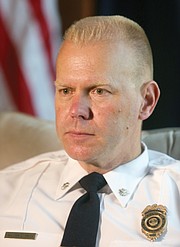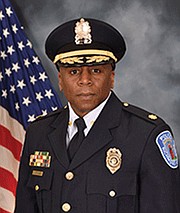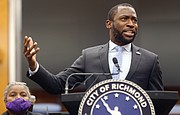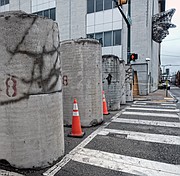Booted out
After days of protests and videos of police tear-gassing and pepper-spraying peaceful crowds, Richmond Police Chief Will Smith was asked to resign Tuesday by Mayor Levar M. Stoney
Jeremy M. Lazarus | 6/18/2020, 6 p.m.
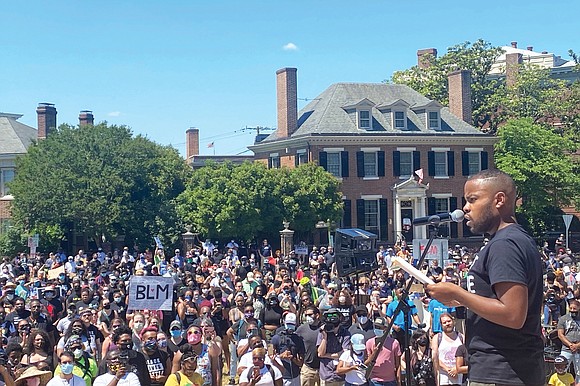
A year ago, new Richmond Police Chief Will Smith was extolled as the best thing since sliced bread when it came to leading 754 sworn officers in the fight against crime.
Mayor Levar M. Stoney, in promoting the then-interim chief to the top job, described the Richmond native as a “thoughtful, detail-oriented, accountable, compassionate and fair” person who had the right stuff to lead the department “and serve our community with a spirit of inclusivity and equity.”
But all that ended Tuesday.
Amid an unprecedented upheaval involving nearly non-stop protests against police brutality and racial injustice, Mayor Stoney on Tuesday dumped Chief Smith like a moldy loaf of bread, referring to him as a roadblock to the progress and reforms in public safety the city needs.
At a hastily called afternoon news conference, Mayor Stoney announced the dismissal of Chief Smith, who has spent 25 years with the department, and the appointment of his chief of staff, Maj. William “Jody” Blackwell, as his immediate replacement as a search for a new chief is conducted. While noting the 52-year-old Richmond native was a “good man” who served the city with grace, Mayor Stoney said Chief Smith no longer met his “high expectations for the Richmond Police Department.”
“At a minimum, I expect (the RPD) to be willing to come around the table with the community to reform and re-imagine public safety,” said the mayor, who is facing a tough re-election campaign this fall against four challengers.
The interim chief, a Marine Corps veteran, also has risen through the ranks during the past 23 years, previously managing the internal affairs department that investigates complaints against officers. Chief Blackwell also has commanded the Fourth Precinct on Chamberlayne Avenue in North Side.
“Interim Chief Blackwell is willing and able to focus on necessary public safety reform, healing and trust building within the community,” the mayor said.
Along with some policy changes, Mayor Stoney promised to work with City Council to develop a community-supported review board.
Mayor Stoney also announced he would create a 20-member task force to re-imagine and recommend changes to “build toward equity and justice. Using a restorative justice framework, we can re-imagine public safety to create a truly safer city for all.”
Ironically, just a few hours after the change, a crowd of about 250 protesters went to the Miller & Rhodes building in Downtown where the mayor lives and chanted his name outside one of the entrances. Someone also tagged the building with graffiti, including “WYA Stoney.”
According to a statement from police, several of the protesters got inside the building, but left peacefully after they were asked by security.
The crowd then marched uptown and tore down another Confederate statute, a memorial to the Richmond Howitzers artillery unit. The statue, near Park Avenue and Harrison Street, stood on the Virginia Commonwealth University campus.
Meanwhile, Chief Blackwell takes over amid continuing unrest and concerns about the potential arrival of heavily armed supporters of the Confederate statues on Saturday, June 20, which raises the prospect of a potential conflict with those seeking to bring the statues down.
The removal of Chief Smith was not unexpected. Police chiefs in Atlanta and other cities also have toppled like Confederate statues in the wake of the outrage and unrest unleashed since the release of a video of a Minneapolis police officer killing George Floyd, a 46-year-old unarmed African-American, who, was made to lie face down handcuffed in the street while the officer kept his knee on Mr. Floyd’s neck for 8 minutes and 46 seconds.
In Richmond, the marches and protests began May 29 and included two nights in which there was a rampage of glass-breaking, looting, vandalism and arson of a GRTC bus that Chief Smith and his officers appeared unable to impact or halt.
The chief’s support in the community began to go south on May 31 when officers conducted a dragnet to enforce curfew. While he claimed that the enforcement was directed mainly at those who would be violent, Chief Smith’s statement was undermined by social media reports from people dragged from cars or arrested walking home who had nothing to do with the protests.
Then came the evening of June 1, when Richmond officers fired tear gas and pepper spray into a peaceful protest crowd at the Lee statue nearly 30 minutes before the start of the city’s 8 p.m. curfew.
The department sought to claim the premature tear-gassing was justified but was forced to back down when it could not provide evidence.
The upshot: Chief Smith and Mayor Stoney were forced to publicly apologize, Richmond Commonwealth’s Attorney Colette W. McEachin was called in to investigate and some of those who were tear-gassed or taken down have lined up lawyers who are filing lawsuits for violation of constitutional rights, including a class action suit filed this week.
The tear-gassing incident left the chief on shaky ground.
Then came the night of Saturday, June 13. A viral video shows a police SUV driving through a group of pedestrians and cyclists near the Lee statue on Monument Avenue.
The department quickly issued a statement that the driver and other officers were attacked and that the conflict happened when people tried block the officer from driving out of the protest zone. Others who were there have disputed the account.
But the image of the officer driving into people appeared to be the last straw for the mayor and others.
Two members of City Council issued sharp rebukes, including 9th District Councilman Michael J. Jones and 5th District Councilwoman Stephanie Lynch.
Expressing dismay, Dr. Jones, who has been the council leader in seeking to dismantle the city’s Confederate statues, went further in accusing the department of interfering with the right of people to peacefully protest. Dr. Jones also called on City Council to cut the police department’s budget and to use those funds for other community services.
On Sunday evening, police fired tear gas into protesters gathered outside police headquarters at Jefferson and Grace streets to demand the firing and indictment of officers involved.
That protest resumed Monday night, when protesters were hit with rubber bullets, tear gas and pepper spray.
Maria Maurer, a 25-year-old digital technology saleswoman, said the crowd was standing and shouting and had thrown nothing when police began their attack. She said she heard the sound of two gunshots and was hit in her neck by a rubber bullet. Her neck is now bruised and swollen. “It was traumatizing,” she said.
She said she then heard a volley and saw tear gas being deployed.
She said any rock throwing was in response to the police aggression, a divergent view from police officials, who reported that that officers were injured by violence initiated by the protesters.
Meanwhile, Interim Chief Blackwell is promising that the department will continue its community outreach and positive youth- and adult-oriented programs.
He also pledged a continued commitment to the department’s six core values: Community Focus, Accountability, Professionalism, Innovation, Shared Trust and Integrity.

